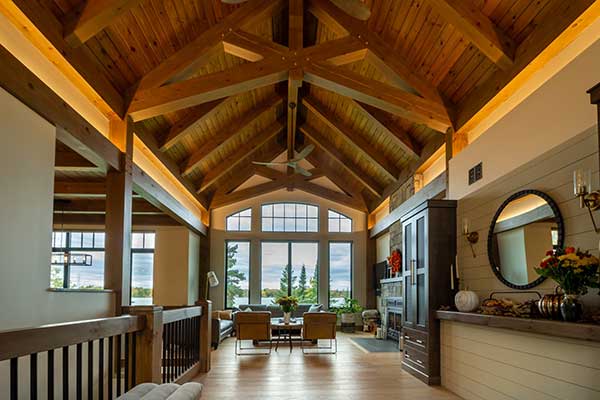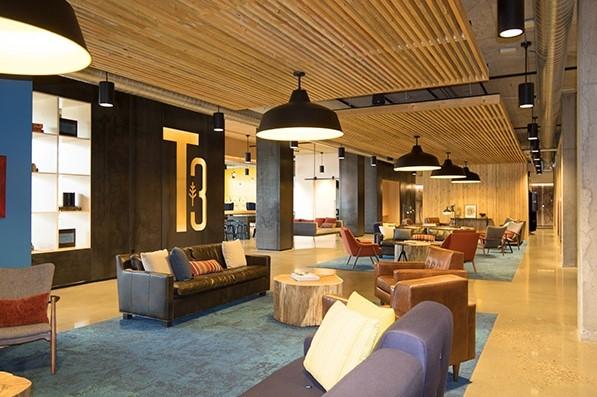You are likely here because something about timber frame construction has caught your attention. If you’re drawn to timber, you’ll find your reasons for admiring it will only grow over time. We’d like to share the top ways that using timber, especially in a timber frame, will positively impact your life. Consider the benefits of building with big wood:

Timber frames: spaces to unwind in and be refreshed.
Nature is calling us: Rolling farmland along the Elroy-Sparta State Trail, Wisconsin.
The use of wood in a school cafeteria – warm, calming, welcoming.

Timber frames carry all the roof loads of a building, freeing up the walls and roof to be fully dedicated to insulation. In contrast, conventionally built homes use 2×6 studs every 16”, and when taken together these represent around 10-12% of the total wall area of a building – a lot of thermal bridging. Worse, insulation needs to be fitted around the studs and this introduces hundreds of tiny gaps where insulation isn’t fully closing the gap between studs.
A timber frame structure combined with insulated wall and roof panels will be over 30% more energy efficient than the same home built with 2×6 lumber.

This chart shows how many kilograms of CO2 are generated to create a beam 7.3m (24’) long, supporting 14.4kN/m (1,060 lbs/ft), in three materials. Numbers do not include CO2 sequestered in materials.
Our use of the Earth’s natural resources is at a critical point. How do timber frames fit into achieving a more sustainable future?
Properly managed forests are a renewable resource whose trees can store carbon for many decades and even centuries. When their wood fiber is used in high quality structures like timber frames, the carbon is kept out of the atmosphere for as long as the structure stands, potentially centuries more. When a building is deconstructed, the timbers can be re-used in a wide range of products from flooring to furniture.
Cornerstone Timberframes is committed to responsible forestry that maintains the capacity of the forest and all species that depend on it. We buy timber from suppliers who share this commitment.
One cubic meter of wood stores 765 kilograms of carbon. Through trees, nature provides humans with the most effective program to limit climate change.
Yes, timber framing involves a financial benefit too. In real estate, the cost of adding timber, is viewed with an eye to how it will impact market demand and eventual re-sale values. A good indication of both these outcomes can be found in the world of commercial properties and leasing. Commercial developer’s have a steely-eyed focus on profits and their rapid acceptance of timber says a lot about the payoffs they’re realizing.
In 2022, lessors were obtaining an average premium of $7.00 US per square foot for buildings constructed with big timber1. In 2018, one of Minneapolis’s first mass timber buildings, the 7 storey, T3 building sold for an impressive $382 US per sq. ft., nearly double the going rate for commercial space in the Twin Cities.
Well designed timber frame structures, both residential and commercial, appeal to a wide clientele who seek the ambience of wood. They consistently achieve higher than market returns when offered for sale.

T3 Building, North Loop, Minneapolis – timber is in demand for new office space.